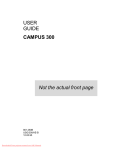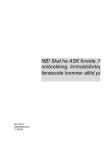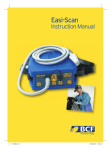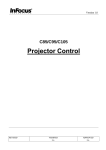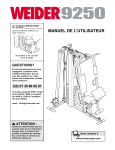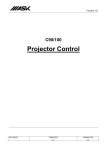Download Ask Proxima 64 Projector User Manual
Transcript
USER GUIDE IMPACT 64 Not the actual front page 801.200A USG/064/AE-A 14.06.95 USER GUIDE IMPACT 64 USER GUIDE LCD PANEL 2 USER GUIDE LCD PANEL TABLE OF CONTENTS INTRODUCTION ..................................................................................... 5 MAIN FEATURES .................................................................................... 5 SUPPLIED MATERIAL............................................................................. 6 OPTIONAL MATERIAL ............................................................................ 6 SETTING UP THE LCD PANEL ............................................................... 7 COMPUTER............................................................................... 8 MOUSE...................................................................................... 9 USING THE LCD PANEL ....................................................................... 11 REMOTE CONTROL................................................................ 11 FRONT PANEL ........................................................................ 13 CONNECTORS ........................................................................ 13 FEATURES............................................................................................ 14 PRACTICAL HINTS AND TIPS............................................................... 18 MAINTENANCE ..................................................................................... 20 SERVICE............................................................................................... 20 TECHNICAL DATA ................................................................................ 21 CONNECTORS ..................................................................................... 24 FCC STATEMENT ................................................................................. 25 ENVIRONMENTAL STATEMENT........................................................... 26 SERVICE INFORMATION...................................................................... 27 CONNECTION LAYOUT ........................................................................ 28 (Foldout Page) 3 USER GUIDE LCD PANEL This publication is printed on recycled paper. The information contained in this user guide is preliminary, and the products described herein are subject to change without prior notice. The symbols and are used in this publication to indicate Warning and Note respectively. 4 USER GUIDE 1 LCD PANEL INTRODUCTION The LCD panel is a state of the art projection device that can be connected to most computers. The ability to display a multitude of greyshades simultaneously, makes it the ideal choice for presenting computer generated text and graphics. Applications include presentations, software training, educational use, advertising, information boards and other situations where a small or large audience shares information. 2 MAIN FEATURES - 64 greyshades BatMouse™ , infrared remote mouse User settings memorized Individual settings for all modes Correct VGA text Infrared remote control Housing footprint fits OHP glass exactly Low weight Intelligent Safecool system False light blocking 4 meters Y-cable 5 USER GUIDE 3 LCD PANEL SUPPLIED MATERIAL A complete set includes the following components : 1. 2. 3. 4. 5. 6. 7. 4 LCD Panel VGA-Cable Cable-Adapt. MACII mon Cable-Adapt. MACII comp. Mouse Cable Mouse Adapter PC Mouse Adapter Mac 8. 9. 10. 11. 12. 13. Power -5, 12, 5 V Power Cable BatMouse Remote Control Batteries Attachè Case User Guide OPTIONAL MATERIAL Optional cables and adapters are available for special computer sources. 6 USER GUIDE 5 LCD PANEL SETTING UP THE LCD PANEL Switch off all equipment before connecting the components. Be aware of static electricity that may build up, especially in the dry season and when operating on synthetic carpets. Discharge any static electricity by touching a metallic surface before you start. Place the LCD panel on top of a transmissive overhead projector (OHP). Select a high intensity type projector, for instance 400W. Best results are obtained in a dimmed room with no direct sunlight shining in. Using the LCD panel on some metal halide OHP’s may cause visible flicker. This will not harm the LCD panel. The following are guidelines for first time set-up: • Connect the cables and power supply as described in the rear foldout page (see Connection Layout). • Attach power to the LCD panel, turn the overhead projector and computer on. Do not switch on the OHP unless the LCD panel is powered, as this may cause permanent damage. If you are going to use a mouse, make sure to power the LCD panel first. For more information on set-up see the following sections on Computer and Mouse. 7 USER GUIDE 5.1 LCD PANEL COMPUTER Connect the LCD panel, computer, monitor and power supply as shown in the rear foldout. Connect the VGA cable (1) between the LCD panel and the computer. Use the Y-split on the computer end to connect the monitor. If you have a Macintosh, EGA, CGA or NEC computer, insert applicable adapters (4) and (5) as described in the table below. Connect the power supply to the LCD panel (3). APPLICABLE ADAPTERS : COMPUTER VGA/SVGA EGA/CGA* MACII c../v../LC/ Quadra/Powerbook/ Duo etc. NEC 9801 ADAPTER None EGA/CGA (option) MACII (640 x 480) (included) NEC 9801(option) * Computer only, monitor not available TO SET UP FROM THE BATMOUSE REMOTE CONTROL : STEP OPERATION 1 Press RESET for default settings 2 Adjust TUNE for a stable image 3 Press POSITION, then use cursor keys to position the image 4 Adjust CONTRAST as desired 8 USER GUIDE 5.2 LCD PANEL MOUSE See the rear foldout when setting up. Connect the mouse to the LCD panel using the appropriate adapter (6) as described in the table below. Then connect the adapter (6) to the mouse cable at the computer end. Finally, connect the mouse cable to the LCD panel (2). For the computer to recognise the mouse, connect all cables and power on the LCD panel before power is applied to the computer. A Y-split is provided with the PC and MAC adapters that enables parallel use of the local computer mouse and the remote mouse. The local and remote mice should not be operated simultaneously, as this may lead to unpredictable positioning of the mouse pointer. If you have a Macintosh, make sure to connect your Mac mouse adapter via the keyboard. The optional PS/2 adapter does not have a Y-split. APPLICABLE ADAPTERS : MOUSE Microsoft 2 key compatible (9 pin serial port) PS/2 compatible mouse Macintosh ADB-bus mouse ADAPTER PC PS/2 MAC USING THE BATMOUSE : STEP OPERATION 1 Control mouse pointer directly with the cursor keys 2 Press LEFT to activate (emulates the left mouse key) 3 Press DRAG to tag an object, move it using the cursor keys, then press DRAG again (or wait 5 seconds) to release the object. 4 Press RIGHT if your application requires emulation of the right mouse key. The centre key of three-key mice is not emulated. 9 USER GUIDE LCD PANEL If double-click does not work properly, try to adjust the double-click rate within the computer application in use. To activate the pull-down menus on a Macintosh computer, use the DRAG key instead of the left mouse key! 10 USER GUIDE 6 LCD PANEL USING THE LCD PANEL The LCD panel has a set of connectors and controls that you need to know in order to operate the device correctly. 6.1 REMOTE CONTROL The infrared BatMouse remote control (RC) is the main user interface to the device. The RC is used to set the LCD panel correctly (to get the best possible viewing conditions) and to control the presentation. The figure shows the different keys of the BatMouse. Set-up should be done once with the application(s) you are running most frequently. Allow some minutes for the equipment to warm up before adjusting. Most settings will automatically be memorized individually for each source for future use. 11 USER GUIDE LCD PANEL The 'MEM' column in the table below indicates whether the setting is memorized for each source. For a detailed overview, see the Features section. BATMOUSE KEYS : CONTROL FUNCTION CONTR Contrast (ratio between light and dark colors) BRIGHT Brightness (whiteness) TUNE Adjusts the stability of the image ON/OFF Turns the panel on/off RESET Defaults to standard settings BLACK Blackens the screen INVERSE Inverts the image PALETTE Selects shading resolution of 64, 16 or 2 FREEZE Holds the image displayed MAC Toggles between the standard MACII and the LC FREQ Adjusts the video frequency POSITION Controls the image positioning with cursor keys CURSORS The four cursor keys control the computer mouse RIGHT This key emulates the right mouse key DRAG This key emulates the drag function LEFT This key emulates the left mouse key and is also used to execute menu commands 12 MEM YES YES YES NO NO YES NO YES YES YES - USER GUIDE 6.2 LCD PANEL FRONT PANEL The front panel keyboard consists of a subset of the remote control keys. ON/OFF CONTROL TUNE BRIGHT RESET ON/OFF 6.3 TUNE BRIGHT RESET FUNCTION Adjusts the stability of the image Adjusts the brightness (whiteness) of the image Defaults to factory settings LED activity indicator CONNECTORS All connectors are positioned on the right hand side of the LCD panel. See the technical data section for pinouts of the various connectors. MOUSE COMPUTER POWER Do not connect any other devices with similar plugs to the connectors of the LCD panel, as this voids any warranty and may cause permanent damage to the device. CONNECTOR POWER MOUSE COMPUTER FUNCTION Low voltage power supply Universal mouse connector Combined connector for analog and digital RGB 13 USER GUIDE 7 LCD PANEL FEATURES The LCD panel has a variety of different features implemented. This chapter explains each feature in detail. 7.1.1 INTELLIGENT SAFECOOL SYSTEM The fan operation is controlled by the overhead projector light (OHP). This safety feature ensures that the fan is always operating as long as the OHP is turned on. When the OHP is turned off, the fan automatically stops to minimize noise. The power supply must be attached to the panel for the fan to work properly. 7.1.2 SET-UP MEMORY The user controlled set-up, that usually is done when the panel is connected to a new computer, is automatically memorized for future use. The set-up information is stored in a non-volatile memory approximately 5 seconds after the last key is pressed. The memory can store 40 different sources/modes. Several sources are predefined, while the remaining are available for customer set-up of sources. See the Technical Data section for compatibility. Custom sources are stored only if their sync pattern differs from any of the previous selections. The panel automatically selects a new memory location. Most settings are stored individually for each mode, including contrast, brightness, tune etc. See the remote control table above. 7.1.3 COLOR MAPPING A color-to-monochrome mapping scheme much like the one used in monochrome television sets is applied. This means that a color image of a human face appears natural in black and white. When using 64 shades, usually no information is lost, even in color intensive applications. 14 USER GUIDE LCD PANEL 7.1.4 SVGA SVGA in 800 x 600 mode is compressed both horizontally and vertically to 640 x 480 resolution. This feature is convenient when displaying irregular images (like pictures, scanned images and coarse graphics). Regular images (patterns, text and fine line graphics) may look distorted due to the downsizing. In this case, we recommend setting up the computer in 640x480 mode for a precise image. 7.1.5 VGA TEXT VGA text is compressed correctly from 720 x 400 to 640 x 400 mode when the image is positioned correctly. The characters maintain their shape, as every ninth pixel is dropped horizontally between each character. 7.1.6 CONTRAST The contrast of an image is defined as the relation between dark and light colors. An image of high contrast is often regarded as ‘hard’, as compared to the ‘soft’feeling of a low contrast image. Low contrast is recommended for long term viewing, while high contrast is used to enhance details. Use the CONTR keys on the remote control (RC) to adjust the contrast. Also see Brightness. The contrast setting is stored individually for each mode. 7.1.7 BRIGHTNESS The brightness is the amount of white in an image. The brightness is adjusted to the ambient lighting conditions. Use the BRIGHT keys to adjust brightness. See also Contrast. The brightness setting is stored individually for each source. 7.1.8 TUNE This feature enables a stable image. An unstable image can be seen as sideways instability or ‘swimming’. Press TUNE until a stable image is achieved. The setting is stored individually for each source. 7.1.9 ON/OFF This switch controls the operation of the panel. When switched on, all functions are active. When switched off, the automatic fan control is still operating, but the image is turned white. The ON/OFF switch is a toggle key. 15 USER GUIDE LCD PANEL 7.1.10 RESET This feature resets most controls to standard settings. See the 'MEM' column in the remote control description, where YES indicates a standard resettable setting. RESET will only reset the active mode. A fundamental master reset may be performed by pressing all four front panel keys simultaneously for approx. 5 seconds. All settings will return to factory defaults. Do not perform a master reset unless it is really required. This operation will also erase all custom sources and modes that have been memorized. 7.1.11 BLACK Use the BLACK key if you temporarily want to suspend the display of images. The BLACK key is a toggle function and the screen goes black when activated. Any key pressed will release BLACK. 7.1.12 INVERSE This option inverts the image. This setting is not memorized. 7.1.13 PALETTE The PALETTE is by default set to display 16 greyshades regardless of application. Some applications may however look better with a different set of shades. Pressing PALETTE will cycle between 2, 16 and 64 greyshades. This setting is retained individually for each mode. RESET defaults to 16 shades. 7.1.14 FREEZE Press the FREEZE button to lock the image displayed. This feature is useful if you want to make changes locally on your computer that should not be seen by the audience. Press FREEZE once more to resume on-line operation. Any other key pressed will also release FREEZE. 7.1.15 MAC The MACII series of computers are equipped with slightly different 640 x 480 graphics adapters that need manual set-up to work correctly. Press this key to toggle between the basic MACII and the LC mode. The setting is retained. 16 USER GUIDE LCD PANEL 7.1.16 FREQUENCY This setting is usually not changed by the user. It is however provided in case of adaptation to special graphics adapters that are close to those in the compatibility list. A bad frequency setting can be seen as an image too wide or too narrow, combined with vertical, unstable bands. Press the FREQUENCY keys left or right to correct the image. The setting is stored individually for each source. 7.1.17 POSITION Due to minor variations in graphics adapters, the horizontal and vertical position may need adjustment. Press POSITION, then use the cursor keys to position the image. The position is stored. 7.1.18 MOUSE The remote control (RC) employs a unique mouse functionality that enables full mouse control of your PC, PS/2 or Macintosh computer. By default, the cursor keys of the remote control emulate the mouse. The LEFT and RIGHT keys emulate the left and right keys on a standard two-key mouse. For Macintosh computers, the right key is not used. The DRAG key is used to emulate the click-and-hold action. To move an object, position the mouse cursor, press DRAG to tag the object, position the object as desired using the cursor keys, then press DRAG again to release the object. DRAG is automatically released 5 seconds after the last key is pressed. The DRAG key is used to activate the pull-down menus on the Macintosh. 17 USER GUIDE 8 LCD PANEL PRACTICAL HINTS AND TIPS This is a list of what to do when things go wrong. Check the symptoms carefully if you experience any problem. The cure may be at your hands! Always press the RESET key and observe that the LED on the LCD panel is flashing. This indicates that the LCD panel receives signals from the remote control.. The LCD image is completely white - Check the ON/OFF key on the remote control The LCD image is completely black - Check the BLACK switch - Check the CONTRAST and BRIGHTNESS settings - Check if the cables are connected and that power is on (LED on front panel) The LCD image is too dark or too light - Check the CONTRAST and BRIGHTNESS settings - Try the RESET key Some shades are unstable or flickering - Try to adjust the CONTRAST or possibly TUNE The whole LCD image appears unstable or misplaced - Try to adjust the TUNE or POSITION - Alternatively, you are most probably connected to an incompatible computer (see the Compatibility section) or video card. See the Features section for frequency adjustment and positioning The cooling fan is not working - The fan operation is controlled by the overhead projector light Is the OHP turned on? - Check that the power supply is attached - Do not use the LCD if the fan appears defective, as overheating may occur 18 USER GUIDE LCD PANEL The remote control is not working - Check if the batteries need replacement - Be sure to point at the projection screen or directly at the IR eye in the front of the LCD panel - You may be too far away from the panel (max. distance 7 m/ 23 feet) The mouse is not working - Make sure that the LCD panel is switched on first - Remember to connect the mouse cables before the computer is switched on - Check if the mouse cable and adapter are properly connected 19 USER GUIDE 9 LCD PANEL MAINTENANCE From time to time, the housing and protection glasses may be cleaned with a damped, non abrasive cloth, possibly using a mild detergent to remove spots. The upper protection glass is not removable, as it only needs cleaning from the outside (the inside is sealed to the LCD module). The lower protection glass can be removed for cleaning. Place the unit upside-down on a soft cloth to avoid scratches. Using two fingers, press the protection glass out of the guide rail and slide out. Replace the glass after cleaning. Be careful not to touch or drop any objects inside the housing as this may cause serious damage. 10 SERVICE This product contains no user serviceable parts. Attempts to modify mechanics or electronics inside the housing will violate any warranties, and may be hazardous. If for any reason the product fails to work properly, first check the previous chapter on hints and tips. If things still do not work, please contact your dealer for technical support. Prepare a list of the symptoms you observe to make the diagnosing easier for your dealer. Remember to include all cables and power supply when returning the goods. If the problem cannot be solved by the dealer, please see the Service Information section. 20 USER GUIDE LCD PANEL 11 TECHNICAL DATA The technical data may change without prior notice in order to improve the product performance. The apparatus is designed for indoor use and should not be operated outside the general environmental limits, as this may lead to permanent damage and violation of any warranties. 11.1.1 GENERAL ENVIRONMENTAL LIMITS STORAGE TEMPERATURE STORAGE HUMIDITY OPERATING TEMPERATURE OPERATING HUMIDITY -20 ~ 60 C (-4 ~ 140 F) 10 ~ 90 percent relative humidity, non condensing 10 ~ 40 C (50 to 104 F) 20 ~ 80 percent relative humidity Allow for a slow acclimatization, after storing at extreme temperatures and humidities, to avoid condensation. Should condensation appear, operate for some time on an OHP, as the heat generated will evaporize the water. 21 USER GUIDE LCD PANEL 11.1.2 DISPLAY UNIT Monochrome display unit connecting directly to external video sources. SIZE WEIGHT POWER LCD CELL GREYSHADES RESPONSE TIME CONTRAST RATIO PIXEL RESOLUTION SCREEN DIAGONAL MOUSE COMPATIBILITY VIDEO FREQUENCY HORIZONTAL SYNC VERTICAL SYNC COMPUTER INPUT APPROVALS 310 x 310 x 40 mm 12.2 x 12.2 x 1.6 inch 2200 grams 4.9 pounds Power -5, -12, 5 V (Universal) Dual scan FSTN 64 130 ms 20:1 640 x 480 9.4 " Microsoft two key compatible serial (9 pin) PS/2 compatible two key Macintosh ADB compatible one key 25 ~ 35 MHz 15 ~ 50 kHz 60 ~ 80 Hz (VGA) 56 ~ 72 Hz (SVGA) 66 Hz (MACII) 0 ~ 0.7 Vpp FCC, Class A, Subpart J, Part 15 22 USER GUIDE LCD PANEL 11.1.3 POWER SUPPLY Primary switched universal type AC to DC converter. INPUT VOLTAGE OUTPUT VOLTAGES CONNECTOR APPROVALS 100 to 250 VAC +5VDC, +12VDC, -5VDC 5 pin DIN male TÜV, UL, CSA, N, S, D, FI 11.1.4 REMOTE CONTROL Infrared wireless remote control. BATTERIES RANGE 2 pcs LR03/AAA 1.5V penlight 7m 23 feet 11.1.5 COMPATIBILITY The unit is predefined for the following interfaces. In addition, the user can configure the panel for other interfaces with a total maximum of 40 definitions altogether (predefined and user defined). MODE VGA, MCGA V FREQ 60,70,72 SVGA EGA 56,60,72 60 CGA MACII NEC 9801 60 66 60 RESOLUTION 640 x 480 640 x 400 640 x 350 720 x 400 (text, compressed) 800 x 600 (compressed) 640 x 200 640 x 350 640 x 200 640 x 480 640 x 400 23 USER GUIDE LCD PANEL 12 CONNECTORS The pinouts of all external connectors are described. 12.1.1 POWER This connector feeds regulated DC power to the panel. 2 4 5 1 3 1 2 3 4 5 5 PIN DIN FEMALE (FRONT VIEW) GND GND +5VDC -5VDC +12VDC 12.1.2 MOUSE This connector is used for mouse control. 7 8 6 5 4 2 3 1 2 3 4 8 PIN MINIDIN FEMALE (FRONT VIEW) MAC ADB PS/2 CLOCK PS/2 DATA RS232 TXD 5 6 7 8 RS232 RTS RS232 RXD RS232 CTS GND 1 12.1.3 COMPUTER This connector relays all sync and data signals from the computer to the panel and back again to the CRT monitor. 9 18 26 1 2 3 4 5 6 7 8 9 1 10 19 ANALOG R IN ANALOG G IN ANALOG B IN NOT USED NOT USED NOT USED ANALOG R OUT ANALOG G OUT ANALOG B OUT 10 11 12 13 14 15 16 17 18 26 PIN HIGH DENSITY DSUB FEMALE (FRONT VIEW) ANALOG R GND IN ANALOG G GND IN ANALOG B GND IN NOT USED NOT USED NOT USED ANALOG R GND OUT ANALOG G GND OUT ANALOG B GND OUT 24 19 20 21 22 23 24 25 26 HSYNC IN C/VSYNC IN DIGITAL GND PCID0 PCID1 DIGITAL GND HSYNC OUT VSYNC OUT USER GUIDE LCD PANEL 13 FCC STATEMENT This equipment has been certified to comply with the limits for a Class A computing device, pursuant to Subpart J of Part 15 of FCC rules. Only peripherals (computer input/output devices, terminals, printers, etc.) certified to comply with the Class A limits may be attached to a computer that complies with Class A limits. When connecting to a peripheral device, a shielded input/output cable is required to ensure compliance with FCC rules. The shielded cable that must be used is supplied with the equipment. Operation with non-certified peripherals or non-shielded cables is likely to result in interference to radio and TV reception. 13.1.1 INSTRUCTIONS TO USER This equipment generates and uses radio-frequency energy and, if not installed and used in accordance with the instruction manual, may cause interference to radio and television reception. It has been tested and found to comply with the limits for a Class A computing device in accordance with the specifications in Subpart J of Part 15 of the FCC rules, which are designed to provide reasonable protection against such interference when operated in a commercial environment. However, there is no guarantee that interference will not occur in a particular installation. If this equipment does cause interference to radio or television reception, which can be determined by turning the equipment off and on, the user is encouraged to try to correct the interference by one or more of the following measures : Reorient the receiving antenna. Relocate the computer with respect to the receiver. Plug the equipment to a different outlet so that equipment and receiver are on different branch circuits. Fasten cables using mounting screws to ensure adequate EMI control. You may require the following booklet from the Federal Communications Commission (FCC) : "How to identify and resolve radio and TV interference problems", available from the U.S. Government Printing Office, Washington, DC 20402, Stock No. 004-000-00345-4. 25 USER GUIDE LCD PANEL 14 ENVIRONMENTAL STATEMENT This product is manufactured to minimize the stress and pollution of the surroundings. Where possible, recyclable materials are used. ITEM PACKAGING MECHANICS ELECTRONICS LCD MODULE RECYCLING / HANDLING Only recyclable materials are used Only recyclable plastics and metal is used. Recycling codes are moulded in the plastic. Metal parts are painted aluminium and steel. No CFC is used during manufacture. No components that require special handling are used. The liquid does not contain toxic or cancer causing materials. No special ventilation is needed when handling a broken cell. Use gloves and wash your hands afterwards to avoid any irritation to skin. The module is largely made up of glass, so handle broken units carefully to avoid wounds. 26 USER GUIDE LCD PANEL 15 SERVICE INFORMATION In cases where a problem cannot be solved by the assistance of your dealer, please call the following number to get an RMA (Return Authorization Number) : +47 69 34 01 55 (Norway) To return the defective unit, package well (preferably using the original packaging material), enclose a copy of your sales receipt and a description of the problem you experience, and ship prepaid to : ASK AS Customer Service Department RMA ................ N-1602 FREDRIKSTAD NORWAY Be sure to include your RMA number on the outside of the shipping box, as units without this number will be returned to sender without processing. 27 USER GUIDE LCD PANEL 16 CONNECTION LAYOUT The foldout shows how to connect the LCD panel to the different computer sources. 28































